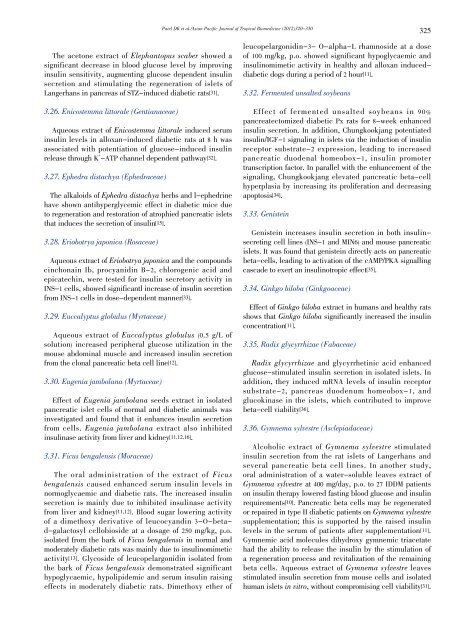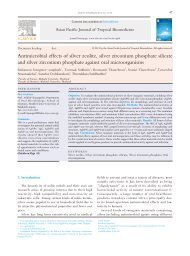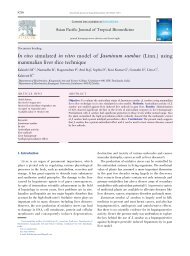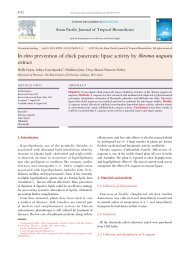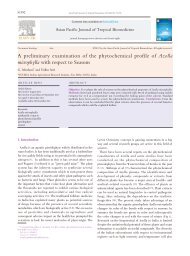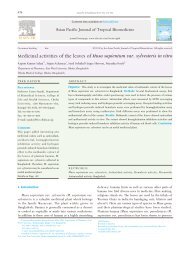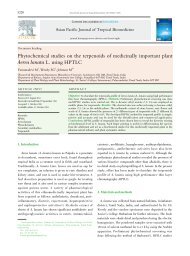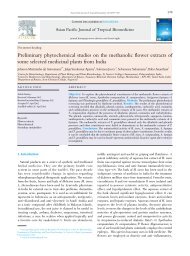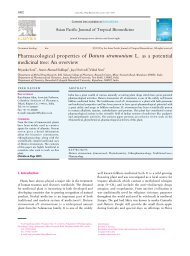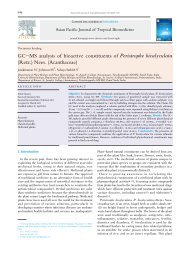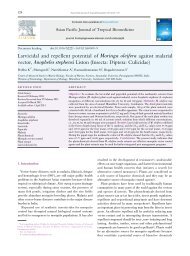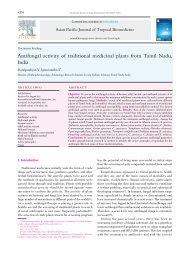An overview on antidiabetic medicinal plants having ... - Apjtb.com
An overview on antidiabetic medicinal plants having ... - Apjtb.com
An overview on antidiabetic medicinal plants having ... - Apjtb.com
You also want an ePaper? Increase the reach of your titles
YUMPU automatically turns print PDFs into web optimized ePapers that Google loves.
Patel DK et al./Asian Pacific Journal of Tropical Biomedicine (2012)320-330<br />
325<br />
The acet<strong>on</strong>e extract of Elephantopus scaber showed a<br />
significant decrease in blood glucose level by improving<br />
insulin sensitivity, augmenting glucose dependent insulin<br />
secreti<strong>on</strong> and stimulating the regenerati<strong>on</strong> of islets of<br />
Langerhans in pancreas of STZ-induced diabetic rats[31].<br />
3.26. Enicostemma littorale (Gentianaceae)<br />
Aqueous extract of Enicostemma littorale induced serum<br />
insulin levels in alloxan-induced diabetic rats at 8 h was<br />
associated with potentiati<strong>on</strong> of glucose-induced insulin<br />
release through K + -ATP channel dependent pathway[32].<br />
3.27. Ephedra distachya (Ephedraceae)<br />
The alkaloids of Ephedra distachya herbs and l-ephedrine<br />
have shown antihyperglycemic effect in diabetic mice due<br />
to regenerati<strong>on</strong> and restorati<strong>on</strong> of atrophied pancreatic islets<br />
that induces the secreti<strong>on</strong> of insulin[15].<br />
3.28. Eriobotrya jap<strong>on</strong>ica (Rosaceae)<br />
Aqueous extract of Eriobotrya jap<strong>on</strong>ica and the <strong>com</strong>pounds<br />
cinch<strong>on</strong>ain Ib, procyanidin B-2, chlorogenic acid and<br />
epicatechin, were tested for insulin secretory activity in<br />
INS-1 cells, showed significantl increase of insulin secreti<strong>on</strong><br />
from INS-1 cells in dose-dependent manner[33].<br />
3.29. Euccalyptus globulus (Myrtaceae)<br />
Aqueous extract of Euccalyptus globulus (0.5 g/L of<br />
soluti<strong>on</strong>) increased peripheral glucose utilizati<strong>on</strong> in the<br />
mouse abdominal muscle and increased insulin secreti<strong>on</strong><br />
from the cl<strong>on</strong>al pancreatic beta cell line[12].<br />
3.30. Eugenia jambolana (Myrtaceae)<br />
Effect of Eugenia jambolana seeds extract in isolated<br />
pancreatic islet cells of normal and diabetic animals was<br />
investigated and found that it enhances insulin secreti<strong>on</strong><br />
from cells. Eugenia jambolana extract also inhibited<br />
insulinase activity from liver and kidney[11,12,16].<br />
3.31. Ficus bengalensis (Moraceae)<br />
The oral administrati<strong>on</strong> of the extract of Ficus<br />
bengalensis caused enhanced serum insulin levels in<br />
normoglycaemic and diabetic rats. The increased insulin<br />
secreti<strong>on</strong> is mainly due to inhibited insulinase activity<br />
from liver and kidney[11,12]. Blood sugar lowering activity<br />
of a dimethoxy derivative of leucocyandin 3-O-betad-galactosyl<br />
cellobioside at a dosage of 250 mg/kg, p.o.<br />
isolated from the bark of Ficus bengalensis in normal and<br />
moderately diabetic rats was mainly due to insulinomimetic<br />
activity[13]. Glycoside of leucopelarg<strong>on</strong>idin isolated from<br />
the bark of Ficus bengalensis dem<strong>on</strong>strated significant<br />
hypoglycaemic, hypolipidemic and serum insulin raising<br />
effects in moderately diabetic rats. Dimethoxy ether of<br />
leucopelarg<strong>on</strong>idin-3- O-alpha-L rhamnoside at a dose<br />
of 100 mg/kg, p.o. showed significant hypoglycaemic and<br />
insulinomimetic activity in healthy and alloxan induceddiabetic<br />
dogs during a period of 2 hour[11].<br />
3.32. Fermented unsalted soybeans<br />
Effect of fermented unsalted soybeans in 90%<br />
pancreatectomized diabetic Px rats for 8-week enhanced<br />
insulin secreti<strong>on</strong>. In additi<strong>on</strong>, Chungkookjang potentiated<br />
insulin/IGF-1 signaling in islets via the inducti<strong>on</strong> of insulin<br />
receptor substrate-2 expressi<strong>on</strong>, leading to increased<br />
pancreatic duodenal homeobox-1, insulin promoter<br />
transcripti<strong>on</strong> factor. In parallel with the enhancement of the<br />
signaling, Chungkookjang elevated pancreatic beta-cell<br />
hyperplasia by increasing its proliferati<strong>on</strong> and decreasing<br />
apoptosis[34].<br />
3.33. Genistein<br />
Genistein increases insulin secreti<strong>on</strong> in both insulinsecreting<br />
cell lines (INS-1 and MIN6) and mouse pancreatic<br />
islets. It was found that genistein directly acts <strong>on</strong> pancreatic<br />
beta-cells, leading to activati<strong>on</strong> of the cAMP/PKA signalling<br />
cascade to exert an insulinotropic effect[35].<br />
3.34. Ginkgo biloba (Ginkgoaceae)<br />
Effect of Ginkgo biloba extract in humans and healthy rats<br />
shows that Ginkgo biloba significantly increased the insulin<br />
c<strong>on</strong>centrati<strong>on</strong>[11].<br />
3.35. Radix glycyrrhizae (Fabaceae)<br />
Radix glycyrrhizae and glycyrrhetinic acid enhanced<br />
glucose-stimulated insulin secreti<strong>on</strong> in isolated islets. In<br />
additi<strong>on</strong>, they induced mRNA levels of insulin receptor<br />
substrate-2, pancreas duodenum homeobox-1, and<br />
glucokinase in the islets, which c<strong>on</strong>tributed to improve<br />
beta-cell viability[36].<br />
3.36. Gymnema sylvestre (Asclepiadaceae)<br />
Alcoholic extract of Gymnema sylvestre stimulated<br />
insulin secreti<strong>on</strong> from the rat islets of Langerhans and<br />
several pancreatic beta cell lines. In another study,<br />
oral administrati<strong>on</strong> of a water-soluble leaves extract of<br />
Gymnema sylvestre at 400 mg/day, p.o. to 27 IDDM patients<br />
<strong>on</strong> insulin therapy lowered fasting blood glucose and insulin<br />
requirements[10]. Pancreatic beta cells may be regenerated<br />
or repaired in type II diabetic patients <strong>on</strong> Gymnema sylvestre<br />
supplementati<strong>on</strong>; this is supported by the raised insulin<br />
levels in the serum of patients after supplementati<strong>on</strong>[11].<br />
Gymnemic acid molecules dihydroxy gymnemic triacetate<br />
had the ability to release the insulin by the stimulati<strong>on</strong> of<br />
a regenerati<strong>on</strong> process and revitalizati<strong>on</strong> of the remaining<br />
beta cells. Aqueous extract of Gymnema sylvestre leaves<br />
stimulated insulin secreti<strong>on</strong> from mouse cells and isolated<br />
human islets in vitro, without <strong>com</strong>promising cell viability[31].


